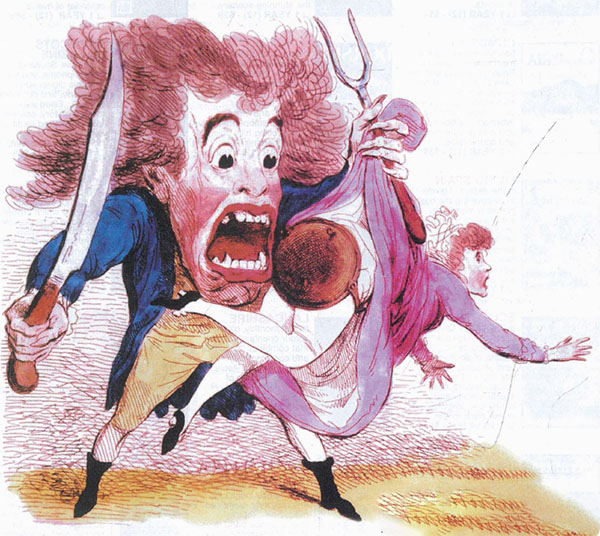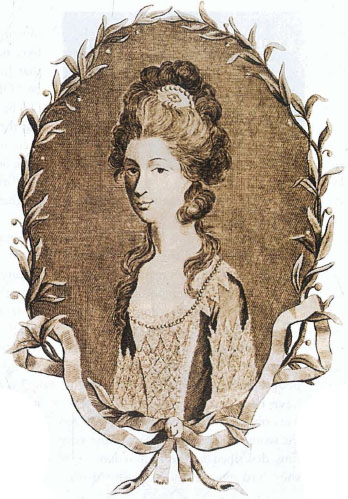
[caption id="TheLondonMonstersentencedtosixyearsinNewgatePrison_img1" align="aligncenter" width="600"]

IT IS OF A MONSTER I mean for to write, who in stabbing of Ladies took great delight; If he caught them alone in the street after dark, In their Hips, or their Thighs, he’d be sure cut a mark.
—“The Monster Represented”
ALMOST 100 YEARS BEFORE THE mysterious killer known as Jack the Ripper terrorized London, another fiend allegedly walked the city’s streets, preying on helpless women and creating a similar nation-wide sensation. Although Jack’s 18th-century predecessor was no murderer, and his exploits, from a 21st-century perspective, seem more ludicrous than terrible, in his own day he had a reputation no less evil than Jack would later earn, and the list of his terrified victims may have exceeded 50 women over a span of more than two years.
Like Jack, the London Monster, as he became known, stalked women. Unlike the more notorious Ripper, however, the Monster preyed not on prostitutes, but on women of high standing, and his victims, investigators observed, were generally young ladies of better than average beauty.
Also like Jack, the Monster armed himself with a knife or some other sharp instrument, the exact nature of which was never determined. But whereas Jack would use his knife to “rip” his victims open and horribly mutilate their bodies, the Monster’s aim seems to have been to slit open his victims’ skirts and prick them in the buttocks. In one or two cases, that “prick” actually penetrated several inches into the flesh, causing a substantial wound, but equally often the ladies who came under the Monster’s blade didn’t even realize they had been cut until they arrived home and found that their skirts had been bloodied.
THE MONSTER’S AIM SEEMS TO HAVE BEEN TO SLIT OPEN HIS VICTIMS’ SKIRTS AND PRICK THEM IN THE BUTTOCKS.
Typically, victims reported that a tall, thin man with a large nose had followed them (although the descriptions varied widely enough to make many people wonder whether there might have been more than one Monster). This obnoxious fellow would speak to the women using what many of the victims described as the foulest language they had ever heard. One need not imagine what this must have sounded like, because the women later testified that his favourite invectives seemed to be “Oh ho! Is that you?” and “Buh!” (To be fair, he was also accused of having threatened to drown his victims in their own blood, which would indeed have been cause for concern.)
While such antics seem almost laughable today, the age in which they occurred was one in which gentlemanly honour still held sway, and even minor insults required that duels be fought to restore the injured party’s dignity. The thought that any civilized man could treat a woman so shabbily therefore shocked well-bred Londoners no less than the brutal murders in Whitechapel would a century later.
Even so, the Monster’s spree had its quixotic side. Once it became known that the Monster preferred young, good-looking, well-to-do women, there came to be a certain cachet to being targeted—so much so that women began faking wounds and concocting stories of having been the object of the Monster’s intentions.
But while it may have been fashionable to be mentioned in the same breath as the Monster while discussing the events of the day over tea in a comfortable sitting-room, gentlemen walking London’s streets noticed a different reaction. John Julius Angerstein, who had posted a reward of £100 for information leading to the Monster’s capture, reported that “No man of gallantry dared approach a lady in the streets after dark for fear of alarming her susceptible nature.” In truth, it is probable that many reported encounters with the Monster were little more than cases of fidgety women panicking at the approach of a well-meaning escort. Eventually the problem grew so bad that a number of men formed the “No Monster Club,” which attempted to reassure the ladies by wearing pins on their lapels that read “no monster.”
Most unfortunate of all was the opportunity that “Monster-mania” provided to the city’s many petty thieves. Public outrage over the Monster’s crimes grew to the point where anyone thought to 1 be the perpetrator stood in immediate danger of being assaulted by a frenzied mob. Criminals used this to their advantage on several occasions by robbing an innocent passer-by, then pointing at him and shouting, “Monster!” In the ensuing hysteria, the thief could make his escape while his terrified victim ran for his life.
[caption id="TheLondonMonstersentencedtosixyearsinNewgatePrison_img2" align="aligncenter" width="348"]

THE DRAMA CAME TO A HEAD on 13th June 1790 when Anne Porter, who had been stabbed by the Monster the previous January, spotted her attacker while walking in St. James’s Park in the company of her mother, two sisters, and Mr. John Coleman. Coleman had just finished boasting about how he would deal harshly with the Monster if he should ever have the chance to meet him when Anne shouted “There he is!” — probably to John’s unspeakable horror.
There followed what must surely have been one of the least dramatic pursuits in criminal history. Coleman, not wanting to lose face in front of the ladies but apparently less than enthusiastic, followed the suspect from a distance. The man walked casually through the London streets, at one point stopping to stare through a shop window, and again to look straight at Mr. Coleman. At one point another man joined Coleman, and for a while the two followed the suspect, until he entered a house on Bolton Street, leaving his pursuers outside. After a few minutes, Coleman’s companion found a better use for his time and walked away.
The suspect re-emerged a few minutes later and walked to a china shop on St. James’s Street, where he chatted with a servant at the door. Still with Coleman in tow, the then walked on. Clearly reluctant to provoke a confrontation but knowing that he could not keep following the man forever without taking some sort of action, Coleman tried to get the man’s attention by making a nuisance of himself. Despite Coleman’s many attempts to incite the man to incriminate himself by doing something “monstrous,” the suspect did little more than increase his pace towards wherever he was heading—not surprising, given Coleman’s strange behaviour. Eventually, the suspect entered a house on South Moulton Street, and Coleman again waited outside, wondering what to do next.
After a few minutes, Coleman worked up the courage to knock on the door and, upon being admitted to the house of a Mr. Smith, who described himself as an old school friend of the suspect, Coleman finally confronted the man—more or less. He said that he suspected that Mr. Smith’s guest had insulted a woman on St. James’s Street and that he demanded satisfaction. The guest said that he would be willing to meet the woman in question at a nearby coffeehouse, but Coleman thought that improper and instead asked for the man’s name and address. The suspect identified himself as Mr. Williams, of Jermyn Street.
Thinking that he had thus identified the suspect, Coleman thanked Mr. Smith and departed. On his way to rejoin the Porters, he seems to have realized that if “Williams” was really the Monster, he probably would not have provided his real name and address. By this point, Coleman probably wished he had never gotten out of bed that morning, but nonetheless he ran back to Mr. Smith’s residence, only to be informed that Williams was gone. In desperation, Coleman ran up and down the neighbouring streets looking for the suspect and, rather incredibly, bumped into him again, in St. James’s Street.
[caption id="TheLondonMonstersentencedtosixyearsinNewgatePrison_img3" align="alignright" width="327"]

Behaving very unlike the man who had eluded so many pursuers over the past two years, Williams made no attempt to run, and in fact reluctantly agreed to go with Coleman to face the woman he had allegedly insulted. When he and Coleman entered the Porters’ parlour, Anne screamed and fainted. Williams, at last accused openly of being the Monster, pleaded his innocence but made no attempt to run. He did, however, claim that if allowed he could produce witnesses to prove he had been at work when Anne was attacked. When he turned to the door as if he were about go collect these witnesses, Anne’s mother waved a fist in his face and told him to sit down. Like a whipped dog, he did so. The terrible London Monster, by all accounts, had been captured.
Whether or not Mr. Rhynwick Williams—he had indeed given his correct name to Coleman—ever slashed Anne Porter, or any woman, is very much open to doubt, but given the temper of the times, he really had no chance for acquittal on the charges brought against him. To a city whose passions had been inflamed to the highest degree by tales of the Monster’s atrocities, Williams was not a mere suspect, he was the object upon which two years’ worth of fear and frustration could be poured out. Reputable lawyers declined to defend him, but even the most capable defender would probably have failed to persuade jurors whose minds were made up before the trial began.
THE ONLY QUESTION SEEMED TO BE how Williams would be charged. By a perversity of 18th-century law, attempted murder was only a misdemeanour, punishable by a relatively short gaol sentence. Intentionally defacing someone’s clothing, though, was a felony punishable by transportation to a penal colony. Hoping for the harsher sentence, the magistrates initially charged Williams with the more serious offence of ruining women’s skirts.
The trial was hardly a landmark of jurisprudence. Spectators routinely cheered witnesses for the prosecution and hissed or laughed at witnesses for the defence. One Monster “victim” claimed that Williams was not the man who had attacked her, and was thus a star witness for the defence, but she recanted her story after the trial began, saying she had never been attacked at all; it had all been a joke. But the trial was so fascinating, she added, that she begged to be allowed tb stay to watch the outcome. Incredibly, her request was granted. Later, during the testimony of another defence witness, this same woman told the prosecutor that she knew the witness was lying and could prove it. When the prosecutor eagerly agreed to let the woman testify, she laughed and again said it was all a joke, and everyone—except Williams, one imagines—agreed that it was a very clever one.
The outcome of this farce was a conviction, but the judge at least had enough sense to realize that Williams should rightly have been tried for a misdemeanour, not a felony. He granted Williams a retrial, which saved him from the threat of transportatiOn, but not from another conviction, despite the sometimes bizarre tactics of his new defence counsel, the outrageous Theophilus Swift, descendant of novelist Jonathan Swift, whose strategy of accusing the Porters of scheming to collect Angerstein’s £100 reward only served to make them more sympathetic figures.
The second trial ended with Williams being sentenced to two years each for three separate assaults. Although he admitted to having once approached Anne Porter and suggesting a liaison, and to having verbally insulted her when she rebuffed him, he denied to the end that he had attacked the Porter sisters or anyone else.





Comments